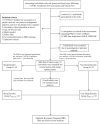Functional Connectivity Alterations Associated with COVID-19-Related Sleep Problems: A Longitudinal Resting-State fMRI Study
- PMID: 39839964
- PMCID: PMC11748004
- DOI: 10.2147/NSS.S488911
Functional Connectivity Alterations Associated with COVID-19-Related Sleep Problems: A Longitudinal Resting-State fMRI Study
Abstract
Background: COVID-19 has led to reports of fatigue and sleep problems. Brain function changes underlying sleep problems (SP) post-COVID-19 are unclear.
Purpose: This study investigated SP-related brain functional connectivity (FC) alterations.
Patients and methods: Fifty-five COVID-19 survivors with SP (COVID_SP) and 33 without SP (COVID_NSP), matched for demographics, completed PSQI and underwent rs-fMRI at baseline and 2-month follow-up. Correlations between FC and clinical data were analyzed by Pearson correlation analysis with Gaussian random field (GRF) correction. The repeated-measures analysis of variance (R-M ANOVA) was completed to explore the interaction with time.
Results: At baseline, COVID_SP exhibited elevated FC: right precentral gyrus (PrG) with left lateral occipital cortex (LOcC)/right PrG, left inferior parietal lobule (IPL) with right superior frontal gyrus (SFG), left hippocampus with right inferior frontal gyrus (IFG). Higher FC between left hippocampus and right SFG correlated with PSQI scores. At 2-month follow-up, decreased FC implicated in emotion regulation, executive function, and memory; increased FC in semantics, attention, and auditory-visual processing. The changes in these regions are correlated with the scores of PSQI, GAD, and PHQ. The Repeated-Measures Analysis of Variance (R-M ANOVA) revealed a significant time interaction effect between sleep and various emotion scales. Moreover, the analysis of the functional connectivity between the right PrG and the right PrG as well as that between the left IPL and the right SFG also discovered a significant time interaction effect.
Conclusion: This study provides insight into the changes in brain function associated with SP after COVID-19. These changes may partially explain the development of SP, and they also changed over time.
Keywords: COVID-19; FC; SP; rs-fMRI.
© 2025 Chen et al.
Conflict of interest statement
Hao-bo Chen and Ling Li are co-first authors for this study. The authors declare no competing interests in this work.
Figures






References
LinkOut - more resources
Full Text Sources

